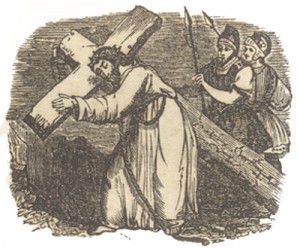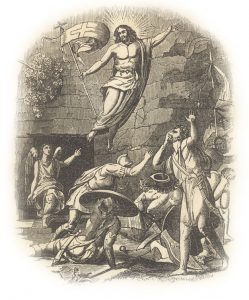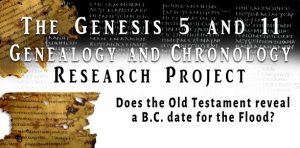 Exploring Jeremy Sexton’s and Henry Smith’s Rabbinic Forgeries Hypothesis
Exploring Jeremy Sexton’s and Henry Smith’s Rabbinic Forgeries Hypothesis
How many of you are familiar with the claim that Jewish Rabbinic scholars forged Biblical history to obfuscate the identity of Yeshua (Jesus) as the Bible’s Messiah?
Regular readers of this blog will appreciate that these accusations are intriguingly intertwined with Old Testament chronology, the 70 Weeks prophecy, and the Biblical Jubilee – three subjects that I’m passionate about and that we’ve explored extensively here.
This week I’d like to look at the Rabbinic Forgeries Hypothesis from a perspective, that as far as I am aware, has not been explored before. I want to look at this subject in light of Yeshua’s (Jesus’) lineage as found in Matthew 1 because I believe this enigmatic list of names offers an important perspective of this ongoing controversy. But most importantly, as I hope to show, this controversy resolves itself in an amazing display of the congruency of Yahweh’s redemptive plan for mankind through Yeshua as described in His word. I hope you’ll stick with me here because I believe you’ll be thrilled at the implications of what we’ll discover.
Authors Note: I apologize for the rough nature of todays article. My wife Winnie who edit’s all of my articles is out of town for a few days visiting our daughter Maranatha. I’m notoriously poor at editing my own articles. Sorry!
This article is Part IV in my exploration of Rabbinic forgery hypothesis. The following links will take you to the previous articles in this series.
Part I: The Septuagint, the Masoretic Text, & Matthew 1
Part II: Matthew 1, the Masoretic Text, & the Bible’s Messianic Symbolism
Part III: The Masoretic Text, Matthew 1, & the Jubilee
Part IV: Sir Isaac Newton, Daniel 9, & the Rabbinic Forgeries Hypothesis
A Two Pronged Hypothesis
Until recently I did not know that this Rabbinic forgery hypothesis was two pronged:
- The first aspect of this theory posits that the 2nd temple era Persian chronology was modified to undermine Christianity’s claims that Yeshua (Jesus) was the Bible’s promised Messiah as prophesied in the 70 Weeks prophecy of Daniel 9.
- The second aspect of this theory, (which I learned of only recently) posits that the Old Testament chronology of Genesis was also manipulated for similar nefarious purposes.
I’ve long known of the 2nd temple aspect of this so called forged chronology. The theory posits that Rabbinic authorities ignored much of the 2nd temple Persian era in order to hide from the Jewish people (and the rest of the world) that Yeshua (Jesus) was a fulfillment of the 70 Weeks prophecy of Daniel 9. In other words by shortening the Persian era they made it impossible for anyone to claim that 490 “weeks” of years mentioned in Daniel 9 were fulfilled in Yeshua of Nazareth.
I’m embarrassed to say that for some time I believed this theory without doing my own due diligence. I’ve subsequently learned that while the Jewish Rabbinic authorities did indeed shorten the Persian era, this deletion of chronology likely had more to do with confusion arising from their own failed Messianic adaptations of the 70 Weeks prophecy and the “divine command to restore and build Jerusalem” than any malicious machinations relating to Yeshua as a fulfillment of the prophecy. As Sir Isaac Newton noted in his Chronology of Ancient Kingdoms Ammended:
Those Jews who took Herod for the Messiah, and were thence called Herodians, seem to have grounded their opinion upon the seventy weeks of years, which they found between the Reign of Cyrus and that of Herod: but afterwards, in applying the Prophesy to Theudas, and Judas of Galilee, and at length to Barchochab, they seem to have shortned the Reign of the Kingdom of Persia. (Sir Isaac Newton. The Chronology of Ancient Kingdoms Amended (Kindle Locations 3439-3441). Heraklion Press. Kindle Edition.)
Yahweh willing in a forthcoming blog post I’ll explain this aspect of the Rabbinic forgery hypothesis in more detail. In this future post I hope to show how the Jewish Rabbinic authorities shortened the Persian era which resulted in the subtraction of 240 years of Persian history. I’ll also explain how ironically some of the very same Christian scholars who believe Rabbinic Judaism forged Biblical history, themselves have borrowed some of the chronological errors resulting from the failed messianic expectations of 2nd temple Judaism and erroneously applied them to their own interpretation of prophecy of 70 Weeks. In other words, inadvertently they are guilty of similar chronological forgeries for which they have condemned Rabbinic Judaism.
Two Versions of Biblical History
Today though, I want to look at the 2nd aspect of the Jewish Rabbinic forgeries hypothesis. The impetus for this blog post is a series of well written articles by Jeremy Sexton and Henry B. Smith which explore the challenging differences in the chronological dates given in the Masoretic (MT) and Septuagint (LXX) texts of Genesis. Those articles are part of an ongoing research project of the Associates for Biblical Research (ABR) entitled: The Genesis 5 and 11 Genealogy and Chronology Research Project.
In the interest of full disclosure, I’m a supporter of ABR. I believe they are a fantastic organization which provides a great service to the body of Christ. They are:
“A Christian Apologetics Ministry Dedicated to Demonstrating the Historical Reliability of the Bible Through Archaeological and Biblical Research.”
I’d encourage you to check out their website and support their great cause.
A 1500 Year Discrepancy
To the purpose of today’s article. In short the controversy surrounds a nearly 1500 year difference for the date of Adam’s creation as given in the Masoretic and the Septuagint texts of the Bible. The question then is which text provides the most accurate version of Biblical history.
In defense of the Septuagint’s chronology of the Old Testament, Mr. Henry B. Smith of ABR describes the conundrum this way:
The million-dollar question is: WHO DUNNIT?
There are two main hypotheses that have been presented in the academic literature: it was either the Alexandrian Jews who translated the LXX Pentateuch in Egypt in 281 BC (the LXX “inflation” hypothesis), or the second century AD rabbis in Israel. We encourage you to read “Primeval Chronology Restored“ and “Who Was Born When Enosh was 90?” to understand why it cannot be the Alexandrian translators, and why the rabbis had strong motive, unique means, and rare opportunity to deliberately reduce the primeval chronology on the order of 1250 years. We submit that only the rabbis could have gotten away with such an egregious and large-scale manipulation of the biblical texts in the proto-MT textual tradition. We will also examine the antediluvian chronology in the Book of Jubilees, its close affinities with Genesis 5 in the Samaritan Pentateuch, and then propose how (many of) the figures in Genesis 5 SP originated. (From Adam to Abraham: An Updated on the Genesis 5 and 11 Research Project: Dec. 16, 2017)
Mr. Smith goes on to explain his hypothesis with the following summary:
…Since Jubilees was immensely popular in Second Temple Judaism, I theorize that the rabbis were aware of this construct in Jubilees and adapted the concept into their Hebrew manuscripts of Genesis 5 to reduce the pre-Flood chronology by 600 years in order to discredit Jesus as the Messiah. However, unlike Jubilees and the SP, the rabbis left Methuselah’s and Lamech’s numbers alone (along with Noah’s and Shem’s) in the MT because of the various problems associated with the onset of the Flood and its chronological matrix.
In summary, I am proposing that the begetting ages in Jubilees and SP Genesis 5 are not derived from a Hebrew biblical text circulating in Israel prior to the time of Christ, but are the result of an artificial scheme invented by the author of Jubilees.
In a recent article date to July 27, 2018 Mr. Smith makes the following comments on page 6:
The rabbinic world chronology in the Seder Olam Rabbah (ca. AD 140–160; Guggenheimer 1998), based on the MT, dates Creation to 3761 BC, placing the arrival of the Messiah to around AD 240 (Beckwith 1981) in the AM 4000 messianic scheme. The Seder Olam was developed and written by the very same rabbis who deflated the MT’s numbers in Gen 5/11 to discredit Jesus and the ascending Church. Simply stated, the rabbinic date of Creation derived from the authoritative Seder Olam places Jesus’ life too soon for him to be the Messiah.
The Seder Olam’s massive chronological deflation scheme is also exhibited in its erroneous post–Exilic chronology, which the rabbis significantly reduced by about 185 years (Hughes, p. 257). This reduction was done in conjunction with their reinterpretation of Daniel 9, which they associated with the Temple’s destruction instead of the Messiah (Beckwith 1981, p. 536). Reinterpreting Daniel 9, adopting the Seder Olam as authoritative, and reducing the primeval chronology in their Hebrew texts worked together as rationales for rejecting Jesus as the Christ. (http://www.biblearchaeology.org/file.axd? file=2018%2f7%2f14+Smith+Septuagint+Chronology+final.pdf)
Mr. Smith’s current view of the Septuagint chronology was influenced by a groundbreaking article written by Pastor Jeremy Sexton in 2015 entitled: Who Was Born When Enosh Was 90?: A Semantic Reevaluation of William Henry Green’s Chronological Gaps Here is a brief excerpt from page 215 of that article which gives you a sense of Mr. Sexton’s perspective:
Notably, we find in this compromised Jewish history “the first mention of the present Hebrew values of Gen. V, xi.”127 That is, the chronologically corrupted Seder Olam Rabbah is our earliest witness to the MT’s begetting ages. Even apart from the unreliable nature of Seder Olam Rabbah, it is significant that our earliest witness to the longer chronology (the LXX) predates our earliest witness to the MT’s chronology (Seder Olam Rabbah) by about 400 years. The evidence suggests that the chronology in the MT did not exist before the second century of the Christian era. Russell concludes that “in the days of Josephus, as well as in those of the annalists who preceded him as compilers from the Jewish Scriptures, there was no difference in the numerical statements of the Greek version, as compared with the text of the original Hebrew.”128
Interpreters have discussed what likely motivated the second-century Jews to reduce the interval between creation and Christ to less than 4,000 years (3,761 years in Seder Olam Rabbah). Prevalent among the ancient Jews and early Christians was the belief that the Messiah was supposed to come in the sixth millennium after creation (between AM 5000 and AM 6000). The Septuagint’s primeval chronology, which existed in Hebrew texts before the second century AD, puts the birth of Jesus at ca. AM 5500. Many scholars have argued that during the second century AD, the Palestinian Jews shortened the chronology in the Hebrew copies of Gen 5 and 11 to remove the lift of Jesus far from the sixth millennium of the world.129
In summary then, according to Mr. Smith and Mr. Sexton, underlying the early church view of the Rabbinic forgeries hypothesis is the claim that early Jewish and Christian messianic expectants believed that the Messiah would come during the 6th millennium (5000-6000) from Adam. Smith and Sexton’s theory then posits that because Yeshua came in roughly the 5500th year from Adam (according to the LXX) that this was close enough to a fulfillment of this expectation that the Jewish Rabbinic authorities decided to forge Biblical history to hide this fulfillment. To be fair to Smith and Sexton they did not originate this hypothesis, it appears that it was a belief held by some Christians of the early centuries of the common era.
 6th or 7th Millennium
6th or 7th Millennium
I think it should be pointed out here that the Messiah appearing in the 6th millennium is a rather weak theory with little support from the prophetic texts of the Bible. I personally have a hard time believing that it was a widespread expectation.
That the early church fathers and some Jewish messianic expectants believed the Messiah would come in the 7th millennium, on the other hand, is well documented. The 7th millennium expectation originated in the idea that 6 days of Creation and the 7th day of rest represented 6000 years of mankind’s struggle on this earth followed by a 7th day or Sabbath of rest for 1000 years under the rule of the Messiah Yeshua.
Bob DeWaay in his article Pre-Millennialism and the Early Church Fathers shows that Justin Martyr, Irenaeus, Papias, Tertullian, Commodianus, Lactantius and Hippolytus of Rome all held some version of (7th day) millennialism (not 6th day).
Hippolytus of Rome (cir. 170-236) for instance explained his belief this way:
For the first appearance of our Lord in the flesh took place in Bethlehem, under Augustus, in the year 5500; and He suffered in the thirty-third year. And 6,000 years must needs be accomplished, in order that the Sabbath may come, the rest, the holy day “on which God rested from all His works.” For the Sabbath is the type and emblem of the future kingdom of the saints, when they “shall reign with Christ,” when He comes from heaven, as John says in his Apocalypse: for “a day with the Lord is as a thousand years.” Since, then, in six days God made all things, it follows that 6,000 years must be fulfilled. And they are not yet fulfilled, as John says: “five are fallen; one is,” that is, the sixth; “the other is not yet come.”
Keep in mind the context here. Hippolytus like many of the early church fathers used the Septuagint version of the scriptures. So they, by the 2nd century AD, understood the 5th day or  5000-6000 years to be almost finished. The MT text by showing 1500 years less for the OT chronology and put the coming of the Messiah (in the 7th day), that much further away.
5000-6000 years to be almost finished. The MT text by showing 1500 years less for the OT chronology and put the coming of the Messiah (in the 7th day), that much further away.
The Rabbinic MT text on the other hand showed that it had only been 4000 years to the birth of Christ and the 6 days = 6000 years theory had another 2000 years to go.
Like many of us today, many of the early church fathers earnestly looked for the messiah’s return and the LXX gave them some comfort of that expectation. As it turned out this expectation was premature. By the LXX rendering of the chronology it has now been roughly 7500 years since the days of Adam. By the Masoretic text it has now been 6000 years from Adam.
If the early church fathers were correct in their expectation of the Messiah reign in the 7th millennium then by the LXX rendering of the chronology we are long past the 7th millennium. By the Masoretic text were have only just begun.
There are a couple important points to draw from this history.
- First, it is unlikely that the 5500th year from creation (for Yeshua’s first coming) is any milestone that would have necessitated the Rabbinic chronological forgery of their sacred texts. Most Jewish messianic expectants looked for the Messiah in the 7th millennium not the 6th.
- Second, the early church also shared the 7th millennium expectation. If they saw the MT text as a threat to their messianic expectations, that threat was to their future expectation of the Messiah’s 2nd coming not His 1st coming.
Before explaining why I believe Matthew 1 challenges the Rabbinic forgeries hypothesis I would encourage you to read Mr. Sexton’s and Mr. Smiths articles in full (see links below). This is an important subject and seeing it from different perspectives is frankly just reasonable stewardship.
From Adam to Abraham: An Updated on the Genesis 5 and 11 Research Project: Dec. 16, 2017
MT, SP, or LXX? Deciphering a Chronological and Testual Conundrum in Genesis 5
Who Was Born When Enosh Was 90? A Semantic Reevaluation of William Henry Green’s Chronological Gaps
Yahweh willing, next time we will continue our exploration of this subject by looking at the chronological and typological nature of Matthew 1 as it relates to the chronology of the Old Testament and the Biblical Jubilee. Stay tuned this is a fascinating and important subject.
To be continued….





Here is a good article on this subject. https://answersingenesis.org/bible-timeline/genealogy/methuselah-primeval-chronology-septuagint/
I don’t really believe debunking a conspiracy of whether the Jews altered the texts deliberately or not matters, what matters is that the Septuagint is much older than the MT, and there is more than 2-3 witnesses that support its chronology. I also do not believe we have missed the millenium by ascribing to the LXX. 1000 years can be symbolic for a long time [eternity] and there are examples in the OT where the number 1000 symbolizes all…such as God owns the cattle on a thousand hills, or His love endures for 1000 generations…in both cases we can agree that God owns all cattle on all hills and His love endures forever. I also highly recommend searching out the topics of eternal torment in “hell” and where/when such doctrines originated from, and also study the topic of “restoration of all things.” I also believe that the kingdom is now [within us], and it is quite an injustice to delegate Christ’s reign as King “later” during the 1000 year reign, as it errs in crediting Him all power and authority now. I DO believe Christ is coming again and we will see Him with our eyes. But I am still studying! Thanks for the info on your site! :c)
errs* in NOT crediting Him
Thank you for your comments Ashley.
Regards,
William